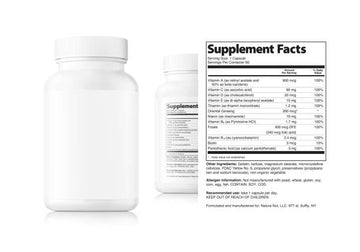It’s important to have high standards—especially when it comes to supplements. With so many options it can be difficult to cut through the noise and find a supplement that’s safe, effective, and suited to your needs.
Before you press ‘PURCHASE’ on the first supplement that search results yield, take a moment to dive deeper, starting with the nutrition label. Just like with food, the label reveals key information about quality, efficacy, and safety.
Both food and supplement nutrition labels are established under standards set by the Food & Drug Administration (FDA). However, dietary supplements fall under a different set of regulations than conventional foods and drugs; they aren’t reviewed for safety, effectiveness, or labeling before hitting the market. The responsibility for ensuring their safety and accurate labeling lies with the company—making it crucial to find a trustworthy brand that provides all necessary information to help you make informed choices.
Why Correct Labeling Matters
Correct labeling is paramount for several reasons:
-
Transparency: Accurate labels inform consumers about what they are ingesting. Misleading or incorrect information can lead to unintended health risks, especially for individuals with allergies or specific health conditions.
-
Dosage Clarity: Labels provide essential information about the recommended serving sizes and the concentration of active ingredients, helping consumers take the appropriate amounts for their health needs.
-
Product Integrity: Brands that prioritize accurate labeling demonstrate their commitment to quality and consumer safety. This integrity can build trust and ensure that you’re making purchases from responsible companies.
How to Read Supplement Labels
1. Serving Size and Servings Per Container
Check the serving size to understand how much constitutes one dose. The "Servings Per Container" informs you of the total doses available. For example, a multivitamin with a serving size of two capsules and 30 capsules in total means you have 15 servings¹.
2. Percent Daily Value (%DV)
The %DV shows how much a nutrient contributes to your daily diet based on a 2,000-calorie intake. This percentage helps you gauge how well the supplement fits into your overall nutrition plan. If a nutrient lacks a %DV, it often means the FDA hasn't established one for that specific nutrient, which is common for certain herbs and non-essential nutrients².
3. Ingredient List
Examine the ingredient list for active components and their amounts per serving. High-quality supplements feature well-researched ingredients that align with your health goals. Be cautious of fillers and artificial additives, which can detract from the supplement's overall quality³.
4. Purity and Potency
Purity refers to the absence of harmful contaminants, while potency indicates the concentration of active ingredients. A supplement with high purity and potency is likely to be more effective. Look for products that provide certificates of analysis to verify these claims⁴.
5. Bioactive Compounds
Bioactive compounds are natural chemicals found in plants that offer various health benefits. Check for the percentage of bioactives on the label; higher percentages often correlate with better health outcomes⁵.
6. Standardized Extracts
If the label states that an extract is "standardized," it means it contains a consistent amount of active ingredients across batches. This is crucial for ensuring reliability and effectiveness, allowing you to track results over time⁶.
7. Third-Party Testing
Look for certifications that indicate third-party testing. Reputable brands often have their products tested by independent labs to verify quality and safety. This provides assurance that what’s on the label is accurate and that the product meets safety standards⁷.
Your Quick Supplement Shopping Checklist
Before you hit "purchase," ask yourself these critical questions:
- Are the key ingredients supported by scientific studies?
- Is the ingredient list clear and free from unnecessary additives?
- Does the brand engage in third-party testing for quality assurance?
By mastering the art of reading supplement labels, you empower yourself to make choices that support your health goals effectively. Take the time to evaluate your options, and prioritize your well-being!
References
1. Dwyer, J. T., et al. (2018). A review of dietary supplements: what you need to know. The American Journal of Clinical Nutrition, 107(2), 213-224. Link
2. Office of Dietary Supplements. (2021). Dietary Supplements: What You Need to Know. Link
3. Kelly, B., et al. (2019). Consumer awareness of dietary supplements: the role of third-party testing. Journal of Nutritional Science, 8, e3. Link
4. Ghosh, P. (2018). Importance of standardization in herbal medicines. Journal of Pharmacognosy and Phytochemistry, 7(1), 114-118. Link
5. Pizzino, G., et al. (2017). Oxidative stress: harms and benefits for human health. Oxidative Medicine and Cellular Longevity, 2017, 8416763. Link
6. Brzezinski, A. (1997). Melatonin in human blood: a review of pharmacokinetics. Clinical Pharmacokinetics, 32(5), 370-380. Link
7. McRae, S. (2014). Nutritional supplements: overview and comparison. Nutrition Research Reviews, 27(1), 1-18. Link




